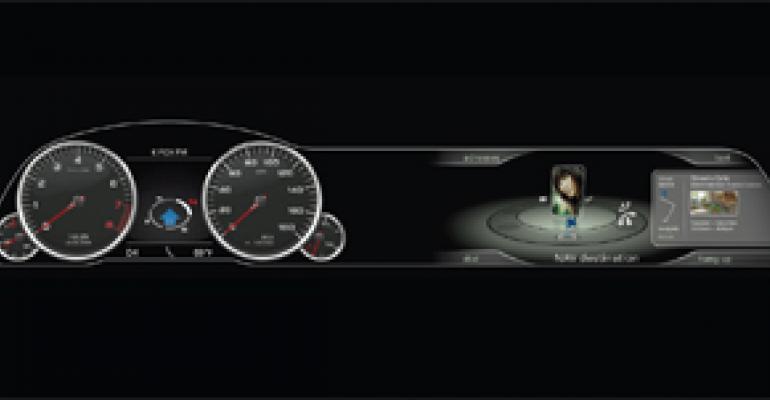
DETROIT – Technology company NVIDIA says its Tegra system-on-a-chip superprocessor could alter the automotive industry dramatically by improving upon existing technologies and ushering in new ones.
Santa Clara, CA-based NVIDIA, best known as a producer of chips for the video-game industry, has been a supplier to the automotive industry for more than a decade, providing graphic solutions that power tools used by designers, product developers and manufacturing engineers.
For example, designers use advanced graphic simulators powered by NVIDIA chips to virtually design a car before it reaches production. Auto makers use the same technology to design virtual-plant-floor work cells to streamline production and quality processes.
The company began to explore how to get its technology into vehicles in 2004. Today, NVIDIA processors power a wide range of infotainment and digital-instrument technology for auto makers including Audi, BMW, Fiat and PSA Peugeot Citroen.
But according to Danny Shapiro, NVIDIA director-automotive group, the Tegra chip’s potential impact on the industry has yet to be fully realized.
“(System-on-a-chip’s) benefits are power consumption, size and weight, all things critical to auto makers,” he tells WardsAuto during a media event here. “Those areas are the physical things, but there is a lot of flexibility in our system as well.”
The physical attributes alone have attracted the attention of nearly every major auto maker,
Packaging the technology is much simpler than what current solutions require. A single SOC, about the size of a dime, can replace several central-processing units and miles of wire now used in vehicles. The CPUs and wiring not only take up size and weight but also add cost and complexity to the manufacturing process.
![<link rel="stylesheet" data-cke-saved-href="http://subscribers.wardsauto.com/galleries/files/lightbox.css" href="http://subscribers.wardsauto.com/galleries/files/lightbox.css" type="text/css" media="screen" />
<script data-cke-saved-src="http://subscribers.wardsauto.com/galleries/files/prototype.js" src="http://subscribers.wardsauto.com/galleries/files/prototype.js" type="text/javascript"></script>
<script data-cke-saved-src="http://subscribers.wardsauto.com/galleries/files/scriptaculous.js?load=effects" src="http://subscribers.wardsauto.com/galleries/files/scriptaculous.js?load=effects" type="text/javascript"></script>
<script data-cke-saved-src="http://subscribers.wardsauto.com/galleries/files/lightbox.js" src="http://subscribers.wardsauto.com/galleries/files/lightbox.js" type="text/javascript"></script>
<p><a data-cke-saved-href="http://subscribers.wardsauto.com/galleries/2011/NVIDIA-gallery.jpg" href="http://subscribers.wardsauto.com/galleries/2011/NVIDIA-gallery.jpg" rel="lightbox[plants]" title=" NVIDIA technology powers advanced instrument clusters. ">View Image Larger</a></p>](http://subscribers.wardsauto.com/images/2011/10/NVIDIA-display.jpg)
Shapiro says Tegra SOCs could be used to power existing technologies, including traffic-sign detection and lane-departure warnings, with more simplicity and likely at lower cost.
Auto makers including Audi and Volkswagen already use Tegra chips in their digital instrument clusters. Future applications powered by Tegra may offer yet-to-be seen technologies, including fully reconfigurable instrument panels.
Shapiro envisions a panel that lets a driver configure it in a way that mimics the way the IP looked from when the vehicle debuted to its modern iteration.
“We are talking to one customer about having almost a slider, where you could move through time and have this retro look and feel all the way through to a futuristic look, all on the same dashboard,” he says.
The system could be made a preference, much like memory seats and mirrors, and could alter itself depending on the individual driver.
Other possible future applications include fully 3-dimensional instrument panels, in which controls appear to hover in the air. But there would be several obstacles to overcome, Shapiro says, including how to produce such images without 3-D glasses.
But some 3-D technologies are much closer to reality; greater use of 3-D images in heads-up displays is the next likely step.
“It could display a virtual street sign that you would pass that would say, ‘Based on your navigation system, you turn right ahead,’” he says. “Or you could see an arrow on the road and follow it. I think that’s something that would happen first.”
NVIDIA hopes to make inroads in the emerging field of electrified vehicles. Shapiro says the Tegra chip is 50 times more energy-efficient than a traditional CPU, making it attractive to EV manufacturers looking to squeeze every additional mile out of their vehicle.
The lighter weight also will help boost range.
“EV potential is huge,” Shapiro says. “As you start to have more and more electric systems or processors, we will be controlling more of them and displaying information on those.”
NVIDIA is working with EV manufacturers in both mature and emerging markets such as China.
Shapiro says NVIDIA, like most auto makers and suppliers, views China as a huge growth opportunity, but it’s unlikely the company’s products will be found on low-cost vehicles.
“Our current strategy is not low cost,” he says. “We’re not trying to just win business based on cost.”




